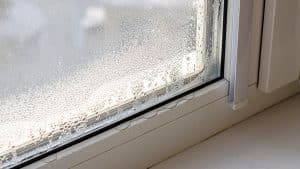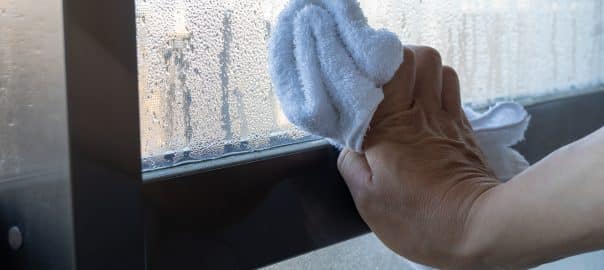Managing Condensation In Your home
Condensation can be a common issue, especially with modern, energy-efficient windows that trap heat and moisture inside.
While condensation may seem like a minor inconvenience, excessive moisture can lead to mould and mildew, potentially affecting your home’s interior and even invalidating your guarantee if proper ventilation isn’t maintained.



Here’s a guide on what condensation is, why it forms, how new windows can help reduce it, and the best ways to manage the condensation on your windows effectively:
- Enhanced Insulation: New windows are built to retain warmth inside your home, meaning that the interior glass surface stays warmer, even during colder weather. This helps prevent condensation, as there’s less chance for warm indoor air to cool down and release moisture on the glass.
- Energy Efficiency: Double- or triple-glazed units with gas-filled cavities (often filled with argon or krypton gas) create an extra layer of insulation. These layers reduce heat loss, maintaining a more stable indoor temperature and minimising the conditions that cause condensation.
- Modern Glass Coatings: New windows often come with low-emissivity (Low-E) coatings, which reflect heat back into the room. This technology not only saves energy but also helps prevent indoor condensation by keeping the glass surface warmer.
- Built-in Ventilation: Many new windows are designed with trickle vents, allowing a small amount of controlled airflow. This flow of fresh air can help manage humidity levels, reducing the risk of condensation.
In essence, new windows work to maintain a balanced temperature indoors and regulate airflow, making it easier to control moisture levels. While they don’t entirely eliminate the need for ventilation, their efficient design makes it easier to prevent condensation from building up.
Internal Condensation
Internal condensation forms on the inside of your windows when warm, moist indoor air comes into contact with the cooler glass. This is common in rooms with high humidity, such as kitchens, bathrooms, and laundry areas. To prevent internal condensation, you must ensure proper ventilation and avoid excessive humidity.
External Condensation
External condensation forms on the outside of your windows, especially on cold, clear mornings. This indicates that your windows are performing well, as they’re effectively keeping heat inside your home. The outer glass pane stays cooler because modern coatings and gas-filled cavities within the glass prevent heat transfer to the outside. This type of condensation is normal and will usually disappear as temperatures rise throughout the day.
Because new windows are highly efficient and draught-proof, they limit the natural escape of heat and moisture from the home. Without ventilation, this trapped moisture can lead to condensation and, in severe cases, mould growth. To prevent this, always keep trickle vents open if your windows have them, or consider opening windows periodically to allow air circulation.
Note: Failure to ensure adequate ventilation can invalidate your window guarantee.
Note: Failure to ensure adequate ventilation can invalidate your window guarantee.
Managing condensation starts with reducing indoor humidity and maintaining good ventilation. Here are some effective tips:
Heating and Air Circulation
- Consistent Heating: Keeping your home at a consistent temperature reduces the difference between indoor and outdoor temperatures, helping prevent condensation on windows.
- Ventilation: Use extractor fans in kitchens and bathrooms and open windows periodically to release humid air.
- Move Furniture: Keep furniture slightly away from walls to allow air to circulate, reducing the chance of damp and mould formation.
In the Kitchen
- Use Pan Lids: Cover pans when cooking to limit the amount of steam released.
- Turn on Cooker Hoods: Extract moisture directly from the cooking area by using a cooker hood.
- Keep Doors Closed: Contain moisture within the kitchen by keeping doors closed while cooking.
In the Bathroom
- Shorter Showers at Lower Temperatures: This reduces the amount of steam produced.
- Run the Bathroom Fan: Turn on the extractor fan during and after showers to draw moisture out of the room.
- Dry Bathmats Outside: Bathmats can retain moisture, so hang them outside to dry rather than leaving them in the bathroom.
Laundry Tips
- Dry Clothes Outdoors or Use a Dryer: Avoid indoor drying whenever possible, as wet clothes release a significant amount of moisture.
Vent Tumble Dryers Properly: Ensure dryers are vented to the outside or located in well-ventilated rooms with closed doors to contain humidity.
- Check for Water Leaks: Address any leaks in pipes or around windows that could increase indoor humidity.
- Use Indoor Plants that Reduce Humidity: Peace lilies, Boston ferns, and spider plants can help absorb moisture in the air.
- Consider a Dehumidifier: A high-efficiency dehumidifier can make a big difference in reducing overall humidity levels, especially in high-moisture areas.
- Inspect for Broken Seals: Damaged seals on windows or doors can lead to water ingress, increasing humidity.
- Ensure Vents Are Functioning: Make sure vents are not blocked and are installed to direct air outside.

Manage humidity and ventilate your home
Condensation on windows is natural, especially with high-performing, energy-efficient windows that keep warmth inside. The key is to manage humidity and ventilate your home properly.
By following these guidelines, you’ll not only reduce condensation but also prolong the life of your windows and maintain a healthier indoor environment.
Remember: Preventing condensation is about finding the right balance of heat, ventilation, and moisture management.








